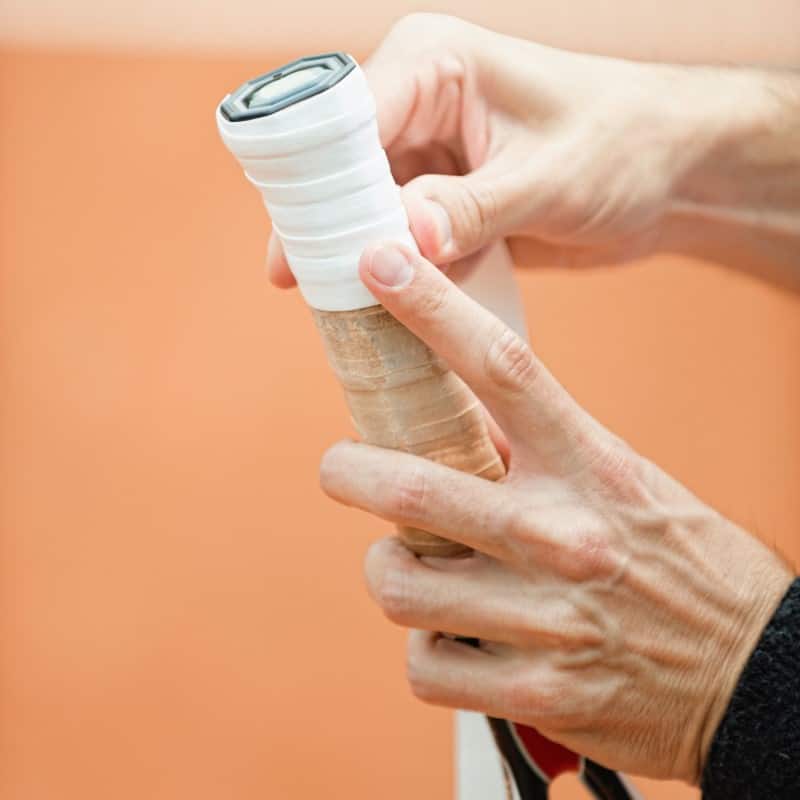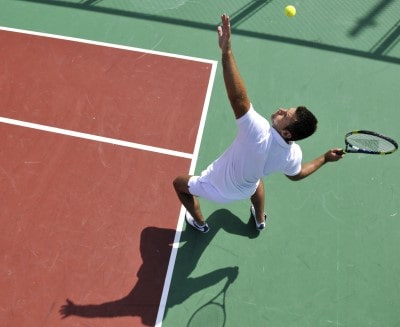Tennis grips play a big part in your performance. I am well aware of how many tennis players may not even realize that they have to replace their tennis grip or even that there are such things as an overgrip and a base grip (both of which need to be replaced).
Everybody learns, and knowing when to replace your grip is one of the first things you need to know.
So when should you replace your tennis grip?
Base and replacement grips should be changed every 2 to 12 months, depending on how often you play and their type. Leather grips are usually changed less often than synthetic grips. Overgrips should be changed as often as possible, which is usually between 2 to 40 hours of play.
That would be the TL:DR version of this article. However, there are some caveats that you should be aware of—especially if you want to make sure you are playing to the best of your abilities.
You don’t really want to give yourself any handicaps. Below you will find more in-depth information.

How Long Do Tennis Grips Last?
Let’s start with the basics before we move on. We need to establish two things first.
There are two main types of grips in terms of their purpose and usage. There is (1) base grip and (2) overgrip.
The base grip is the grip that comes with the racquet. It is already wrapped around the racquet’s handle and good to use. Overgrips, on the other hand, do not come with the racquet. They are purchased separately and placed by the player.
Replacement grips are intended to replace the base grip when it is due for a replacement. Both base and replacement grips fall in the same category.
There are two types of base grips. They are either leather or synthetic. Leather overgrips are a lot more long-lasting compared to synthetic grips, regardless if used with an overgrip.
Overgrips are made from a soft cloth-like material that is padded and usually does not last a long time. Overgrips are meant to protect the base grip and provide more grip, padding, and sweat absorption.
How Long Does the Overgrip Last?
Overgrips typically last between 3 to 40 hours of play. If your hands sweat a lot, the overgrip will wear out faster and may need to be changed in as little as 3 to 24 hours of play. However, if you don’t sweat, the overgrip may last longer, depending on the quality of the overgrip you use.
And, in terms of sessions, an overgrip will last between 1 to 10 sessions.
Usually tennis players change their overgrips every 3 to 6 sessions (or about once a week). But in certain cases, with some lower quality overgrips they may need to be changed in as little as 1.5 hours of play.
Players that play often, at least a few times per week, should change their overgrips about one to two times a week. Players that play less often should change their overgrips one to two times per month.
How Long Does the Base (Replacement) Grip Last?
The base or replacement grip lasts longer than the overgrip.
Base and replacement grips last between 1 week to 12 months, depending on how often you play and the quality of the grip. Synthetic replacement grips last shorter, on average, about 1 to 8 weeks, especially if used without an overgrip. Leather grips, on the other hand, are a lot more durable and last a lot longer—between 3 to 12 months.
You can extend the life of your base and replacement grip by using an overgrip. (Sometimes almost by twice.) If you do not use an overgrip, the base grip will wear out and lose its stickiness and cushioning noticeably faster.
Read nore: Grip vs Overgrip,What Is the Difference?
How to Know When You Should Change Your Tennis Grip?
But, in order to be able to make the right call, first, you need to know what to look for. So let’s take a look at the signs of a grip that needs to be changed.
Look for any signs of wear and tear. The more you use your tennis grip, the more it will start showing signs of wearing out. If your grip starts to rip apart or fray (frequently, this will happen in the area around the base of your palm or thumb), it should be changed as soon as possible.
Look for discolorations. After a while, the overgrip will start accumulating dirt and sweat and will start to go dark—a good sign that it needs to be replaced.
If you notice that the grips—both the base and overgrip—start to lose their tackiness and become more slippery, this is a good sign they should be changed.
Another good telltale sign that it is time for a grip to be changed is if it starts losing its cushioning. However, grips lose their cushioning very slowly, and gradually and frequently, you may not notice how the padding has changed over time.
What Happens If You Do Not Change Your Tennis Grip?
Tennis grips are used to provide better grip, shock absorption, moisture absorption, and comfort. As both the base grip and the overgrip wear out over time, they will start losing those capabilities and will be able to provide neither comfort nor shock absorption.
In fact, playing with a severely worn out and tattered grips can do more harm than good.
Since the grips will not have the same grippiness—especially overgrips that, when subjected to moisture, can get loose and slippery—you will need to grip the handle harder. This will strain your arm, forearm, and shoulder muscles, wrist, and fingers. Furthermore, this will hamper the fluidity of your movement and technique. A stiffer grip will make your swings slower and reduce your feel for the ball.
By losing their cushioning grips will not be able to provide good levels of shock absorption. This will lead to your hand and shoulder will take the brunt of it. This may cause your arm and shoulder not just to tire out faster but also may cause injuries.
Worn out grips will inevitably lead to more blisters, too. In order to prevent that, you need to make sure you are playing with fresh grips.
In addition to that, especially if you sweat a lot, the racquet is more prone to slipping out from your hand. (One slip and you can easily break your racquet.)
And lastly, a fresh overgrip will protect the base grip underneath it. This will not completely prevent the base grip from wearing out; however, it will keep it in good condition and retain its tackiness for a lot longer. This way, you will always have something tacky that you can wrap your overgrip around.
As you can see, not changing your grip will impact and affect your game in a negative way. You will have reduced control over the racquet, tire out faster, and be more likely to hurt or injure yourself and potentially damage the racquet, too.
How to Change Your Tennis Grip Less Often?
Many tennis players find themselves in a situation where they go through a lot of grips as they play.
So the question, “Can you make a tennis grip last longer?” springs into mind. So can you?
As it stands, there are, in fact, a few things you can do to prolong the life of your tennis grip.
Base grips that are used without an overgrip will start to lose their tackiness with time. One of the reasons why that happens is dirt accumulation.
Players are capable of successfully combating the dirt accumulation by using a bit of rubbing alcohol to clean the base grip. (This, however, will not work on overgrips.)
You cannot do much about the lowered tackiness due to the base grip wearing out over time, as this is a natural process. However, using an overgrip will normally significantly improve its longevity.
Overgrips, though, are a lot more prone to wearing out and thus need to be replaced a lot more often.
One interesting way to prolong the overgrip’s life is by flipping it when it starts showing signs of wearing out. Just take it off, flip it and re-wrap it again with the inside now facing out. (And in case if you are wondering, no, washing your overgrip will not do any good.)
Overgrips will wear out faster if they get damp. This is why people that sweat a lot will go through more overgrips. There are a few solutions to that:
- Use wristbands to prevent sweat from going down your hand.
- Use high-quality moisture-absorbing overgrips. (Tourna grip comes to mind.)
- Use a rosin bag or a chalk bag. Both are similar products that will improve your grip.
- Use an antiperspirant lotion or gel.
It is worth mentioning that these techniques are not going to prevent you from replacing your tennis grip. These methods and techniques are useful to improve the longevity of your grip somewhat and, at the same time, potentially improve your performance. (You will still have to replace your tennis grip but less often.)
Read our full review on Best Tennis Grips.


